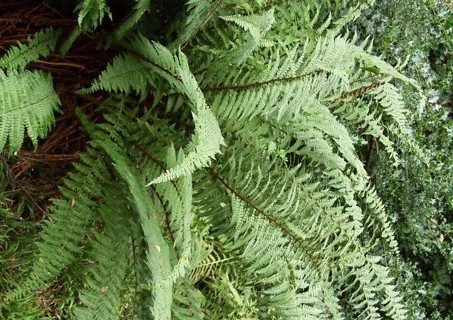Golden-scaled male fern
(Dryopteris caucasica)

Description
Dryopteris affinis, the scaly male fern or golden-scaled male fern, is a fern native to western and southern Europe and southwestern Asia. It is most abundant on moist soils in woodlands in areas with high humidity, such as the British Isles and western France. In the Mediterranean region and the Caucasus it is confined to high altitudes. Dryopteris affinis is virtually evergreen and bears light green fronds 60–160 cm (24–63 in) long, moderately stiff and hard-textured, the rachis at the base of the frond densely covered in yellow-brown scales known as ramenta. The frond is bipinnate, the pinnae up to 8–18 cm (3–7 in) long, the pinnules broad rectangular with the margin most toothed close to the pinna tip. There is a blackish spot at the base of the pinna where it joins the rachis. Individual fronds live for about 1.5 years and remain attached to the rhizome after withering. D. affinis is closely related to Dryopteris filix-mas, distinguished by its usually more robust habit with usually more evergreen fronds, more densely scaly frond stems, and more rectangular (less tapered and lobed) pinnae and pinnules. It is one of the larger European native ferns, with older specimens developing a dense, almost tree fern-like base up to 20–30 cm (8–12 in) high and 30–40 cm (12–16 in) broad. Dryopteris commonly called the wood ferns, male ferns (referring in particular to Dryopteris filix-mas), or buckler ferns, is a fern genus in the family Dryopteridaceae, subfamily Dryopteridoideae, according to the Pteridophyte Phylogeny Group classification of 2016 (PPG I). There are about 300-400 species in the genus. The species are distributed in Asia, the Americas, Europe, Africa, and the Pacific islands, with the highest diversity in eastern Asia.It is placed in the family Dryopteridaceae, subfamily Dryopteridoideae, according to the Pteridophyte Phylogeny Group classification of 2016 (PPG I). Many of the species have stout, slowly creeping rootstocks that form a crown, with a vase-like ring of fronds. The sori are round, with a peltate indusium. The stipes have prominent scales. Hybridization and polyploidy are well-known phenomena in this group, with many species formed via these processes. The North American Dryopteris hybrid complex is a well-known example of speciation via allopolyploid hybridization.
Taxonomic tree:







